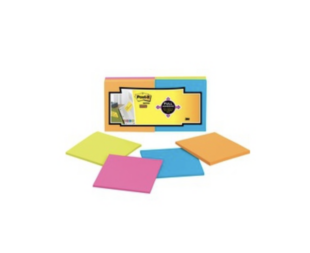
Each year brings seasons for preparation: for example there is back to school season, holiday season which naturally leads into the new year. Each season is accompanied by a ritual of setting meaningful goals. But as much as the goals themselves, it is important to reflect upon the methods used to set them. Notebooks, planners, calendars, and journals are not just tools; they are your facilitators on the journey of intelligent goal setting. Read on to find out what SMART goals are and how they can be effective for meeting your aspirations for the future.
The science behind SMART goals
SMART stands for Specific, Measurable, Achievable, Relevant, and Time-Bound. Each SMART goal you set must meet the all the components of SMART. Research suggests that clearly defined and broken-down goals, especially those that have these specific SMART characteristics, can significantly increase one’s motivation to and likelihood of achieving them. Goals provide direction. When they are SMART, they also offer clarity, motivation, and a higher probability of achievement. By promoting focus and reducing the inclination to procrastinate, SMART goals pave the way for personal and professional growth.
Writing down goals in a journal or notebook, specifically phrased in the SMART manner, engages a different part of the brain, making your ambitions more tangible and visual. It provides precision in what, by when, and how much exactly needs to be achieved. This leads to a higher rate of success than setting goals that are too general or large, and ultimately, overwhelming.
Components of SMART Goals
Every letter in the acronym “SMART” guides us towards a more effective goal-setting approach:
- Specific: Clarity is the first step towards success. Instead of vaguely wanting to “be healthier”, define what that means for you. For example, “I want to walk 5,000 steps daily” as opposed to “I want to walk more” brings greater precision to your ambitions.
- Measurable: How will you know if you’re progressing or if you’ve attained your goal? Setting measurable criteria, like “read 20 pages a day”, allows you to track your progress. Incorporating post-its or sticky notes in your planner can be a visual and satisfying way to see how far you’ve come.
- Achievable: Setting goals that stretch us can be beneficial, but they also need to be realistic. This isn’t about limiting oneself but about ensuring a balance between aspiration and realism. If you actually want to walk 10,000 steps daily, but find that too much to realistically handle, start with 2000 or 5000 steps daily. Once a specified amount of time has passed, you can increase that number incrementally to reach 10,000 by the end of the year.
- Relevant: Your goals should align with where you see yourself in the larger scheme of things. For instance, if you value family above all, a goal related to spending quality time with them would be more relevant than, say, travelling solo for a year.
- Time-bound: Deadlines might be daunting, but they give us a timeframe to work within. Whether it’s a long-term objective or a short-term task, having a clear “due by” date can be a motivator. A calendar plays a crucial role here, helping keep track of these dates.
At the end of your SMART goal setting, you should have a sentence that has all the above elements like, “I want to walk 10,000 steps, five days a week by December 31, 2024.”
Areas you can apply SMART goals to
Goal setting isn’t restricted to any one facet of our lives. Here’s a look at various areas we can focus on:
- Professional: These goals could range from career advancements and building new skills to networking more effectively.
- Personal development: This area includes goals to help you learn a new language or how to play a new a musical instrument or sport.
- Health and wellness: Targets for your physical fitness or focusing on mental well-being fall into this category.
- Financial: These goals can span from saving a particular amount by year-end to investing in stocks or real estate.
- Relationship: Enhancing communication, strengthening bonds, or even dedicating regular family time can be part of this area.
- Hobbies and leisure : Whether it’s dedicating time to paint or planning weekend getaways, these goals include adding enriching, relaxing activities to your life.
Achieving short-term goals

Big dreams often comprise smaller steps. Short-term goals act as these steps. They are immediate, more tangible, and often pave the way to our larger objectives, making them feel less overwhelming to achieve.
Try a simple method: start with your larger goal in your notebook—example: “I want to walk 10,000 steps, five days a week by December 31, 2024. Now, break this down into smaller tasks or milestones—example: 2000 steps by February 15 or 5,000 steps by June 30. Use sticky notes for each of these tasks and stick them onto the pages of your planner. As you achieve each, take the note off. This action of removing a sticky note offers a sense of accomplishment, keeping you motivated.
Thinking about long-term goals
As you consider specific goals, it’s also an opportune time to think beyond the next year. Where do you want to be in 5 or 10 years? These long-term goals provide direction for the short-term goals for each year. They might evolve or even change completely over time, and that’s okay. The journey of goal setting is ongoing, adapting as you grow and circumstances change. A dedicated journal can act as a compass, reminding you of your North Star even as the terrain shifts.

Endeavour to set goals that not only challenge you but also bring clarity and direction. SMART goal setting offers a balanced approach, ensuring your targets are clear, motivating, and achievable. What goals resonate with you for the next year or to the end of 2024? Share your aspirations below and consider recording them in a journal or planner to keep on track on this journey. Remember, the tools and goal setting methods you choose are your companions, making the process as fulfilling as the goals themselves.
This article was drafted using AI technology and then reviewed, fact-checked, and revised by a member of our editorial team.




